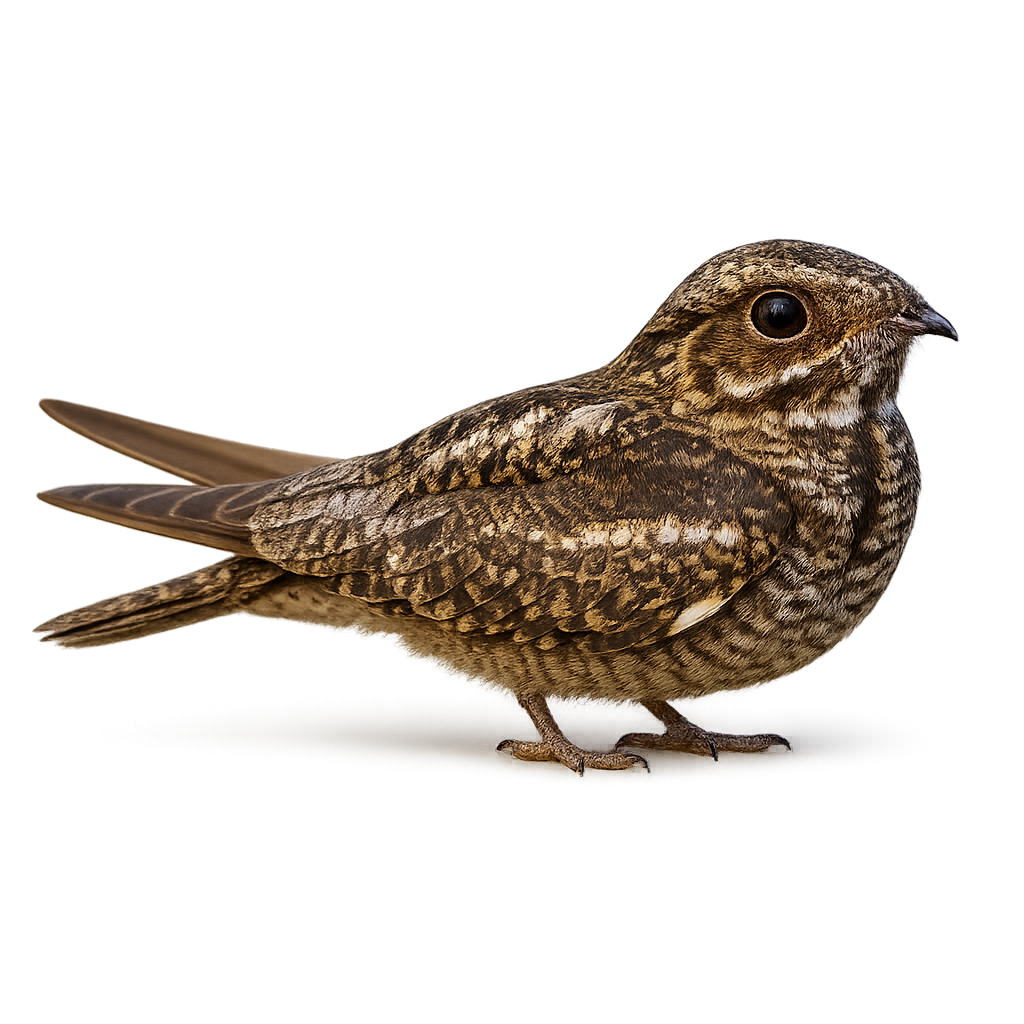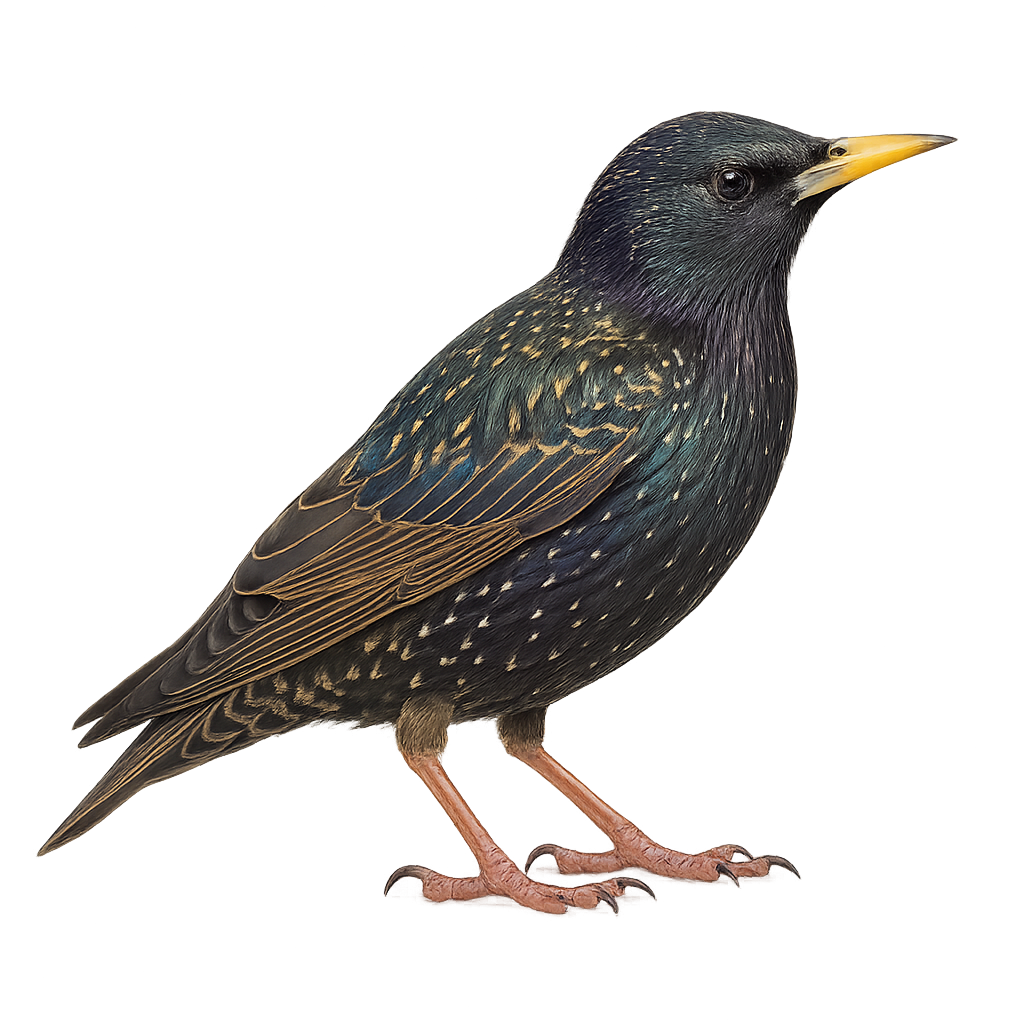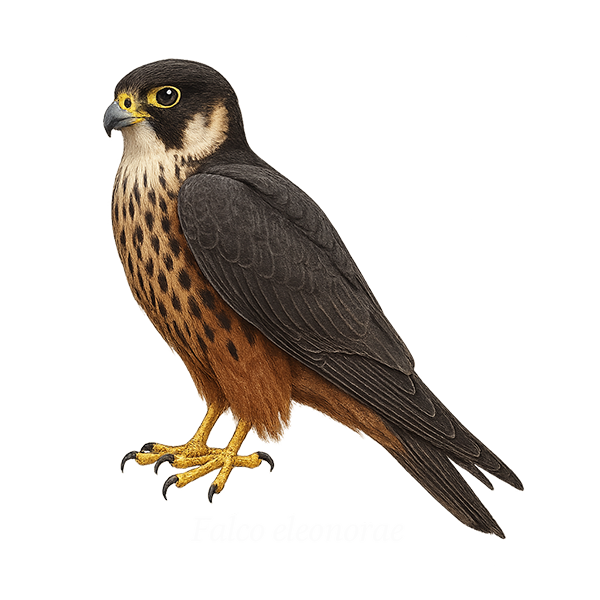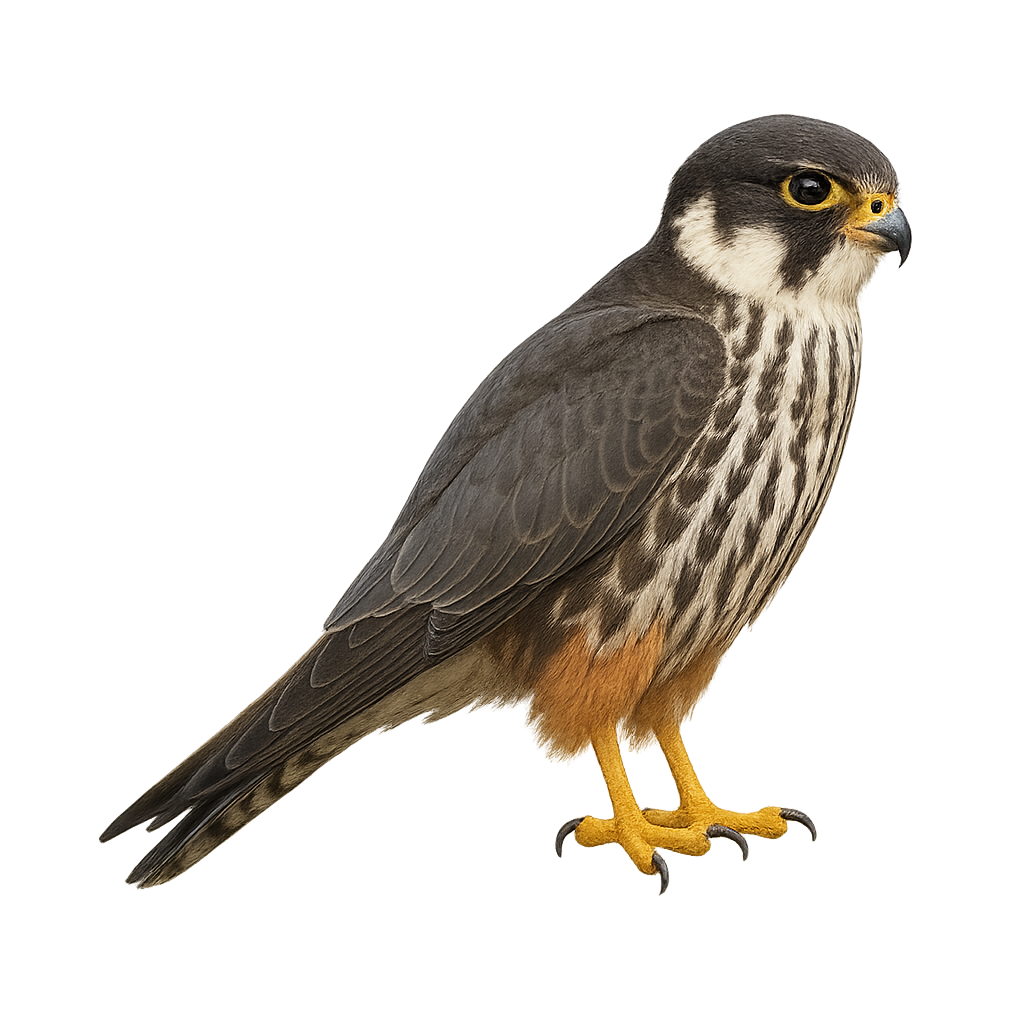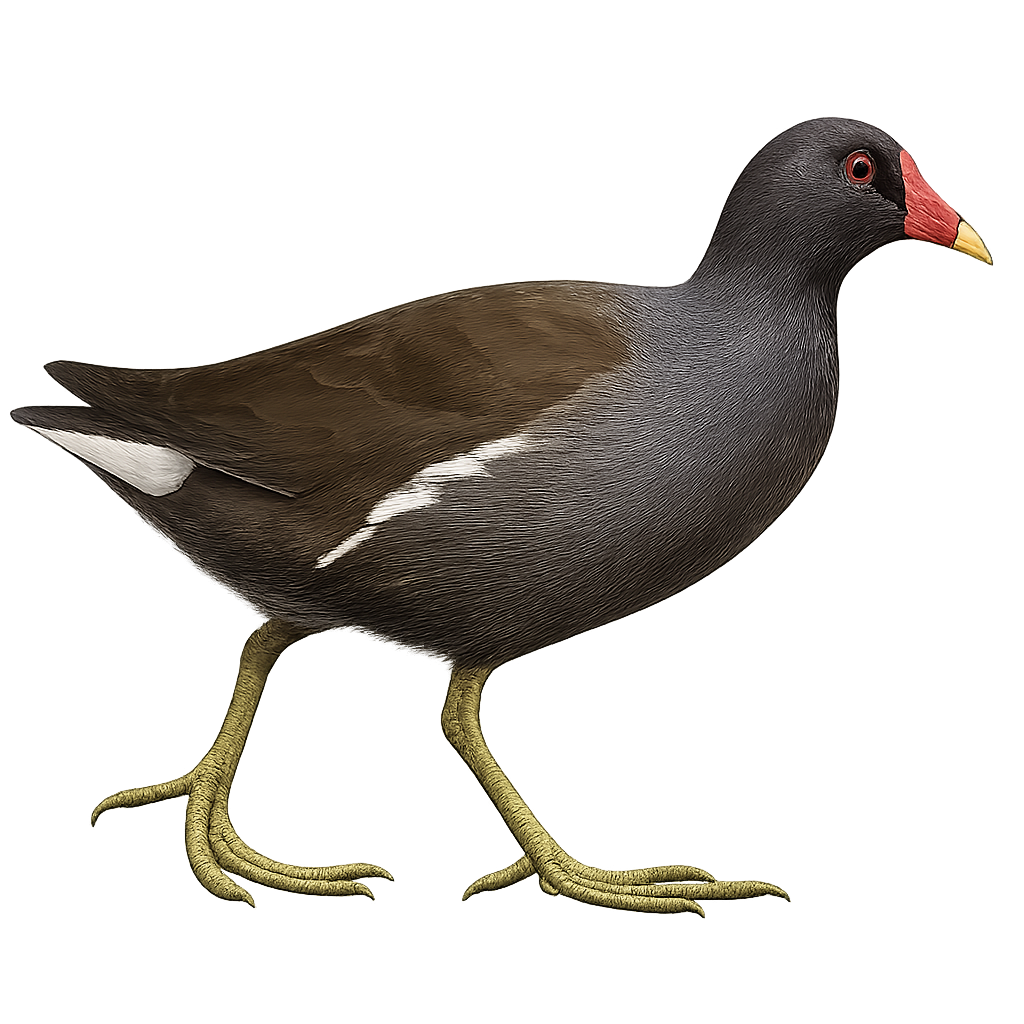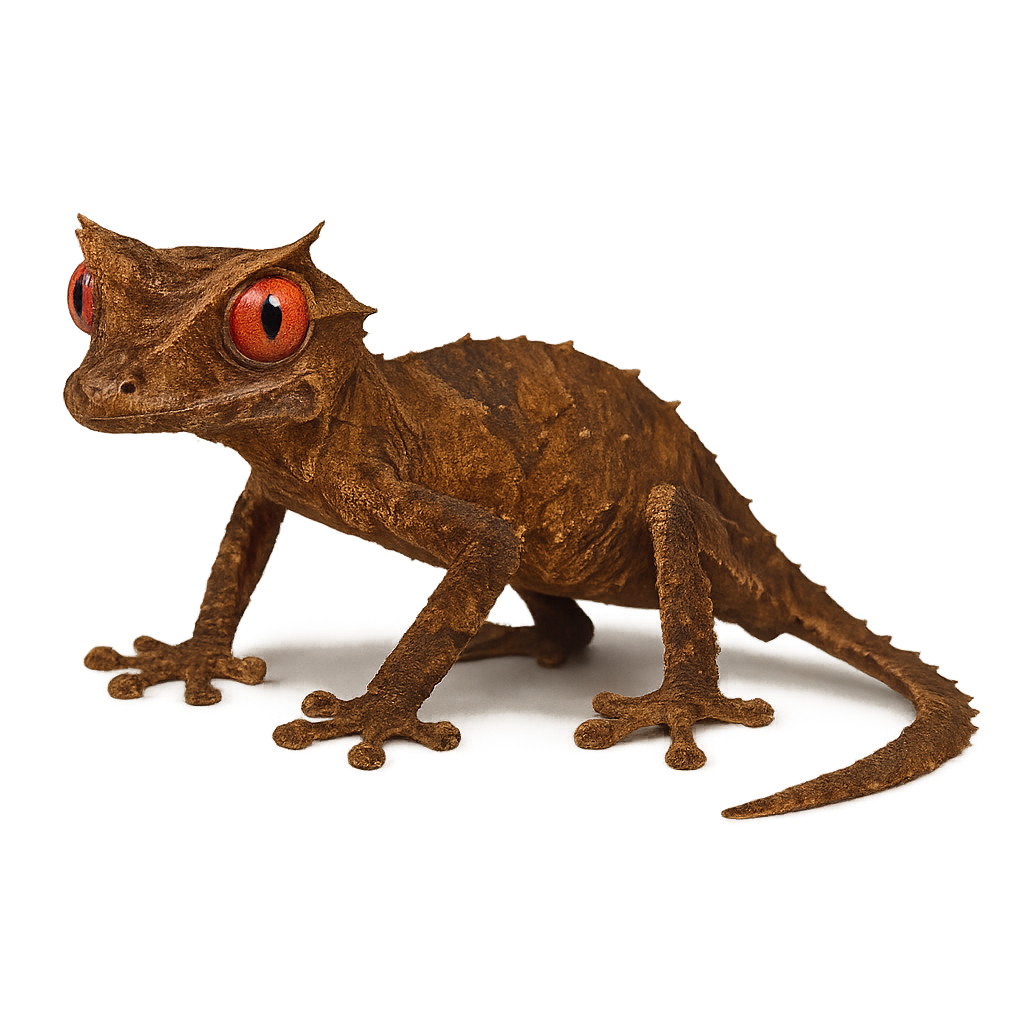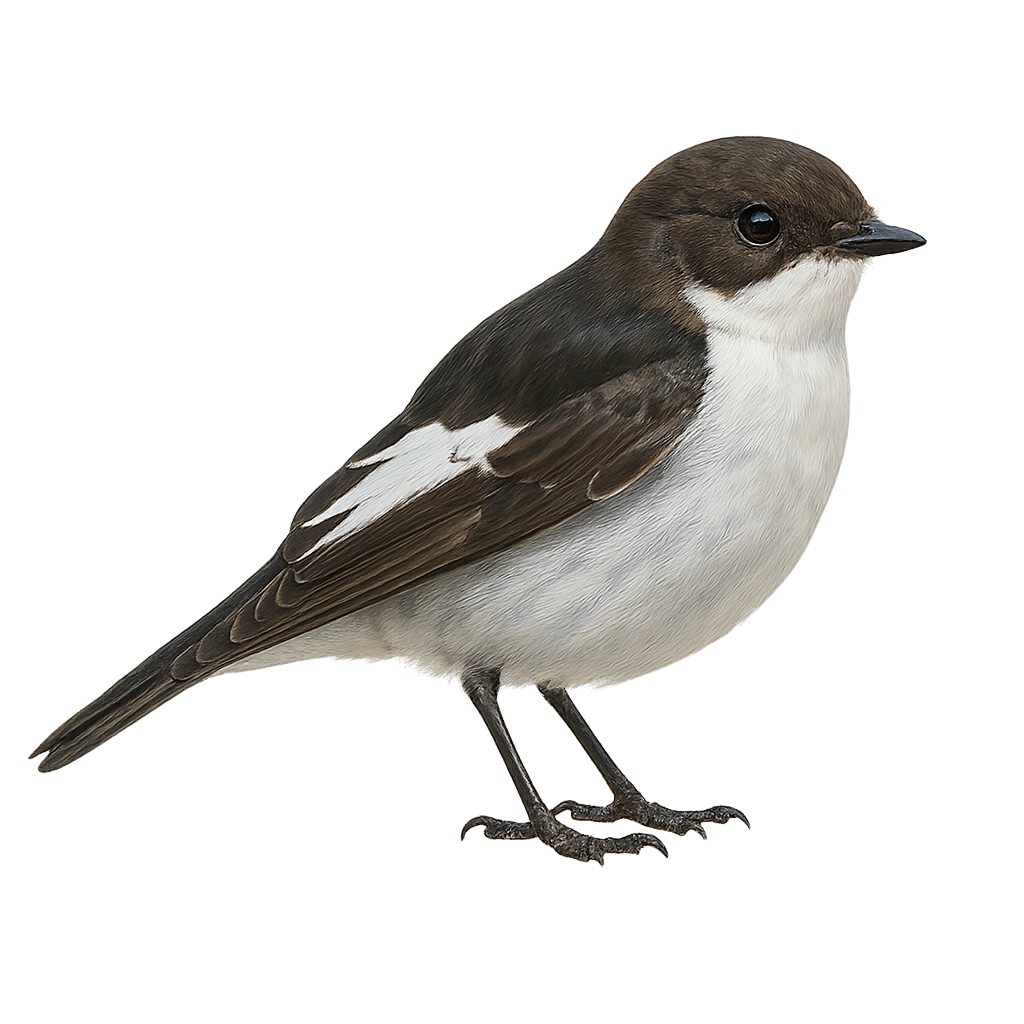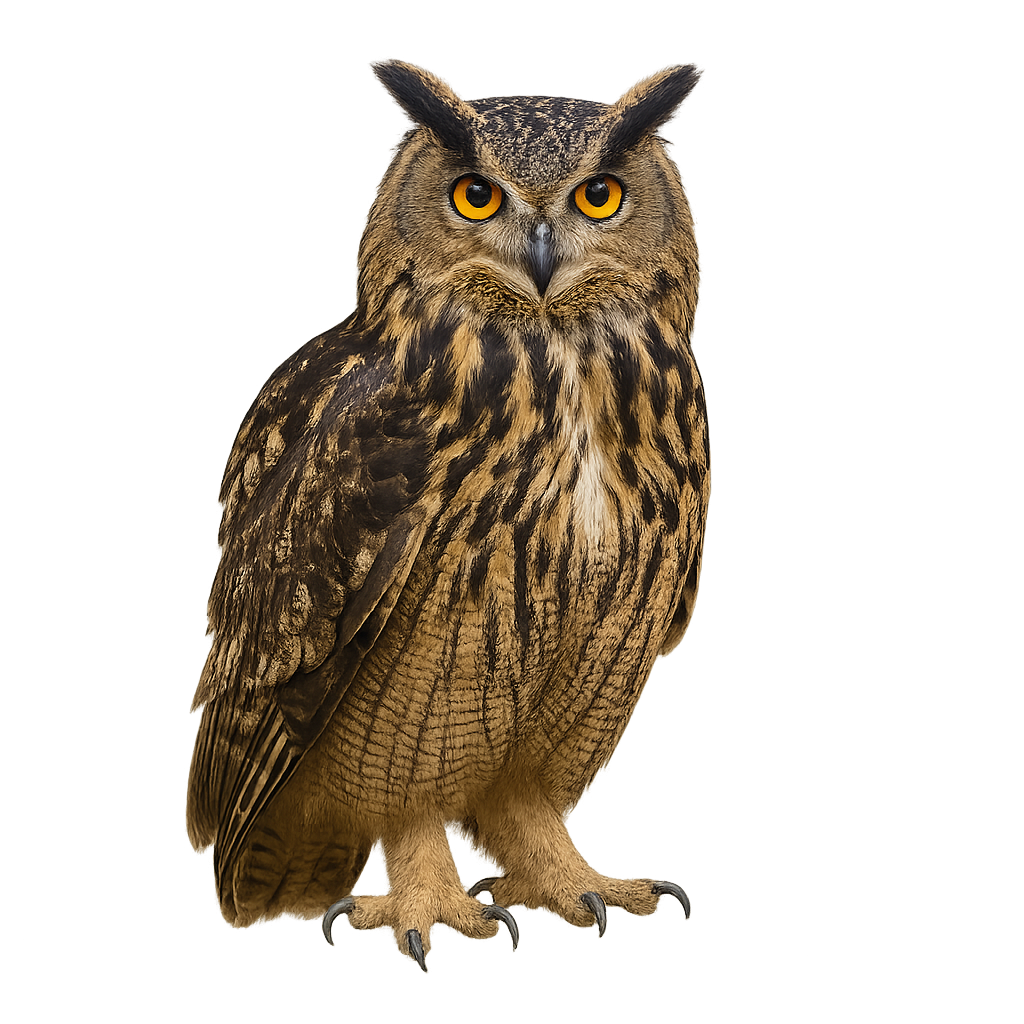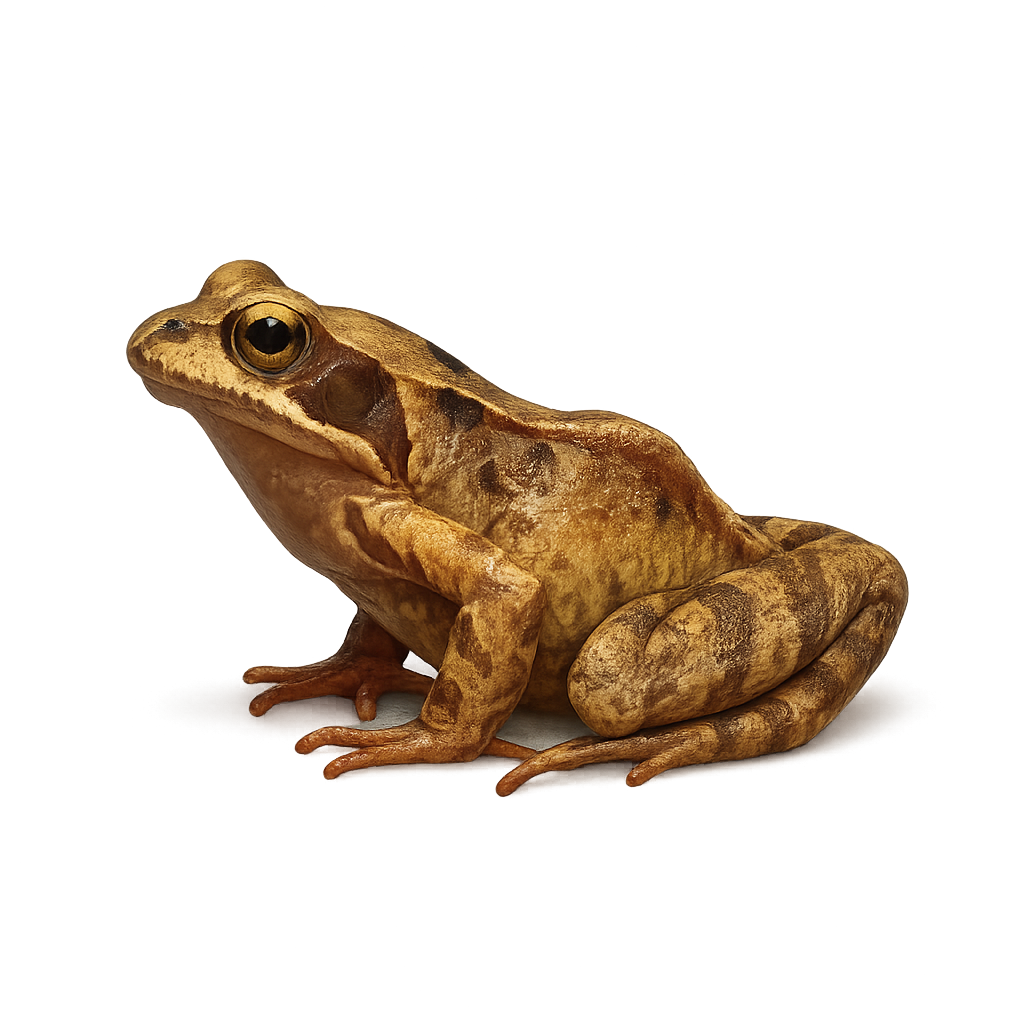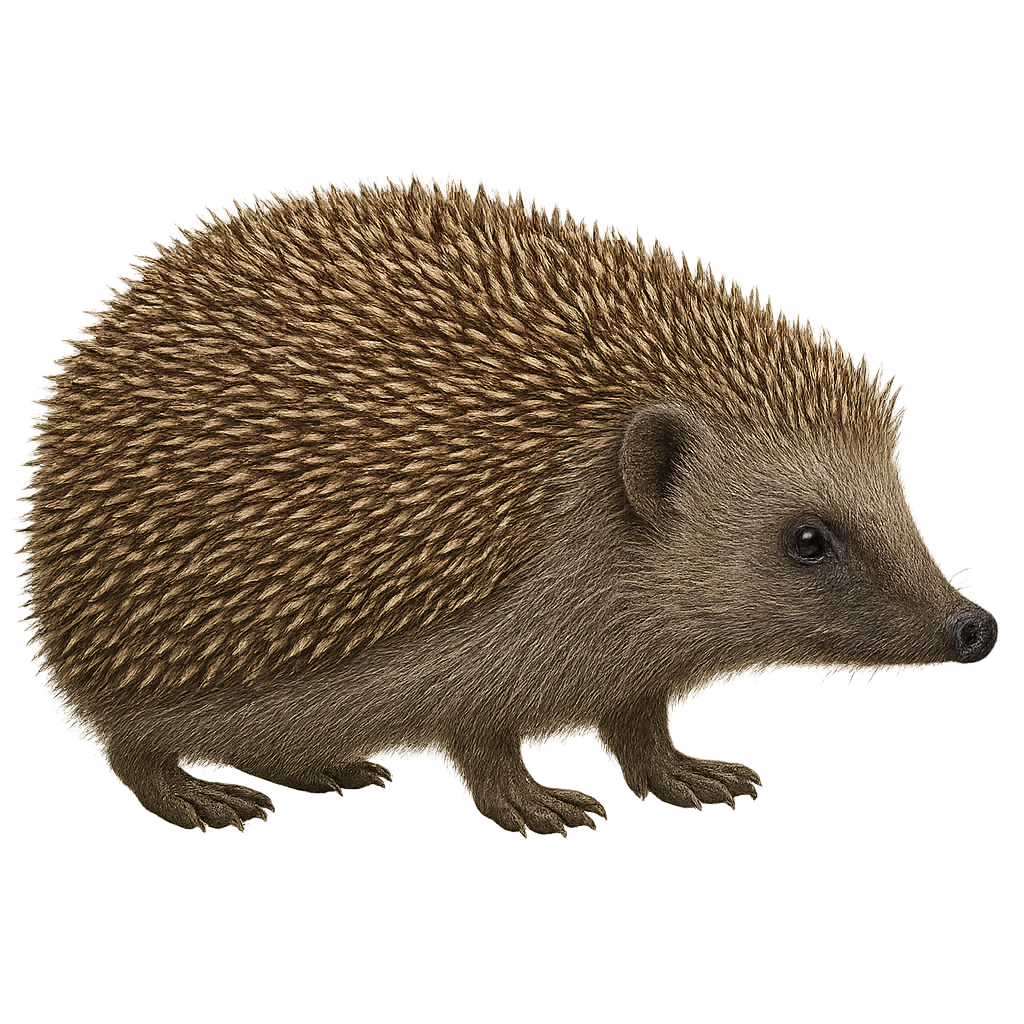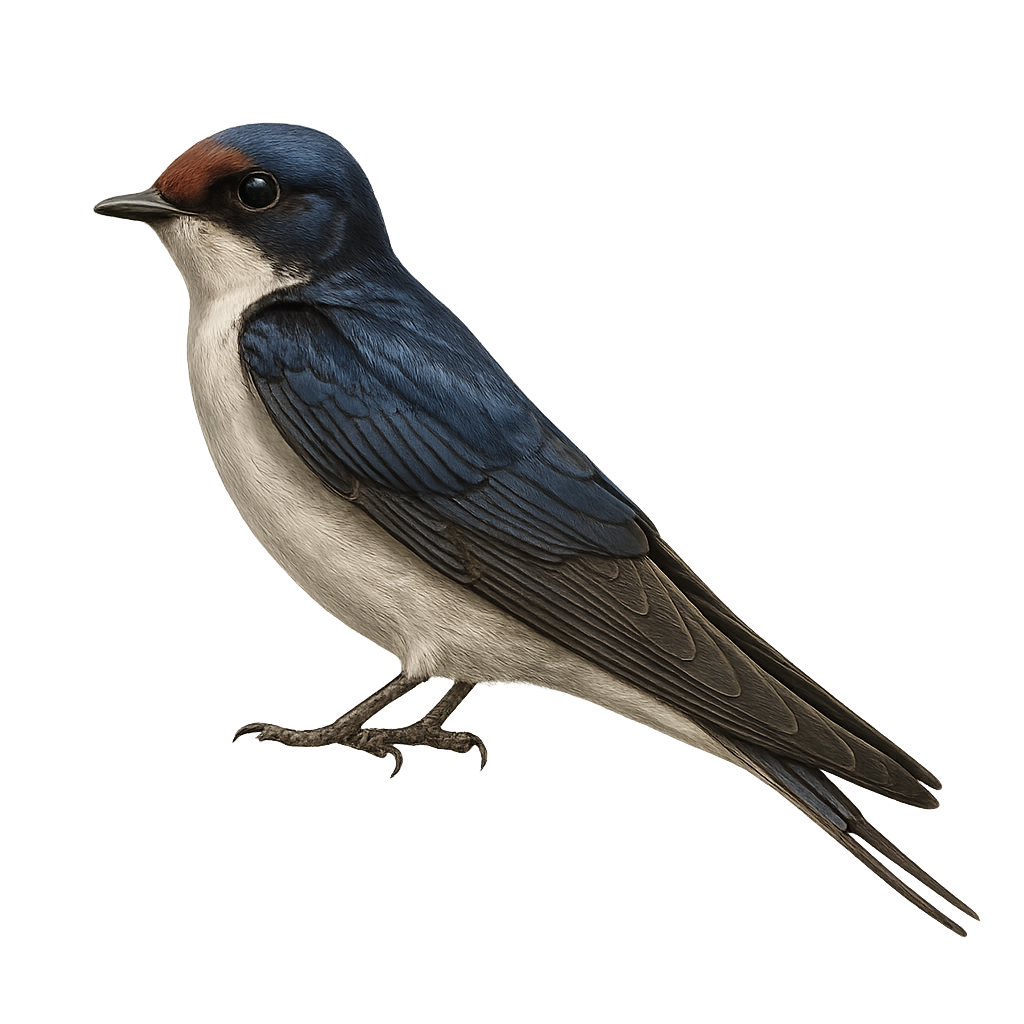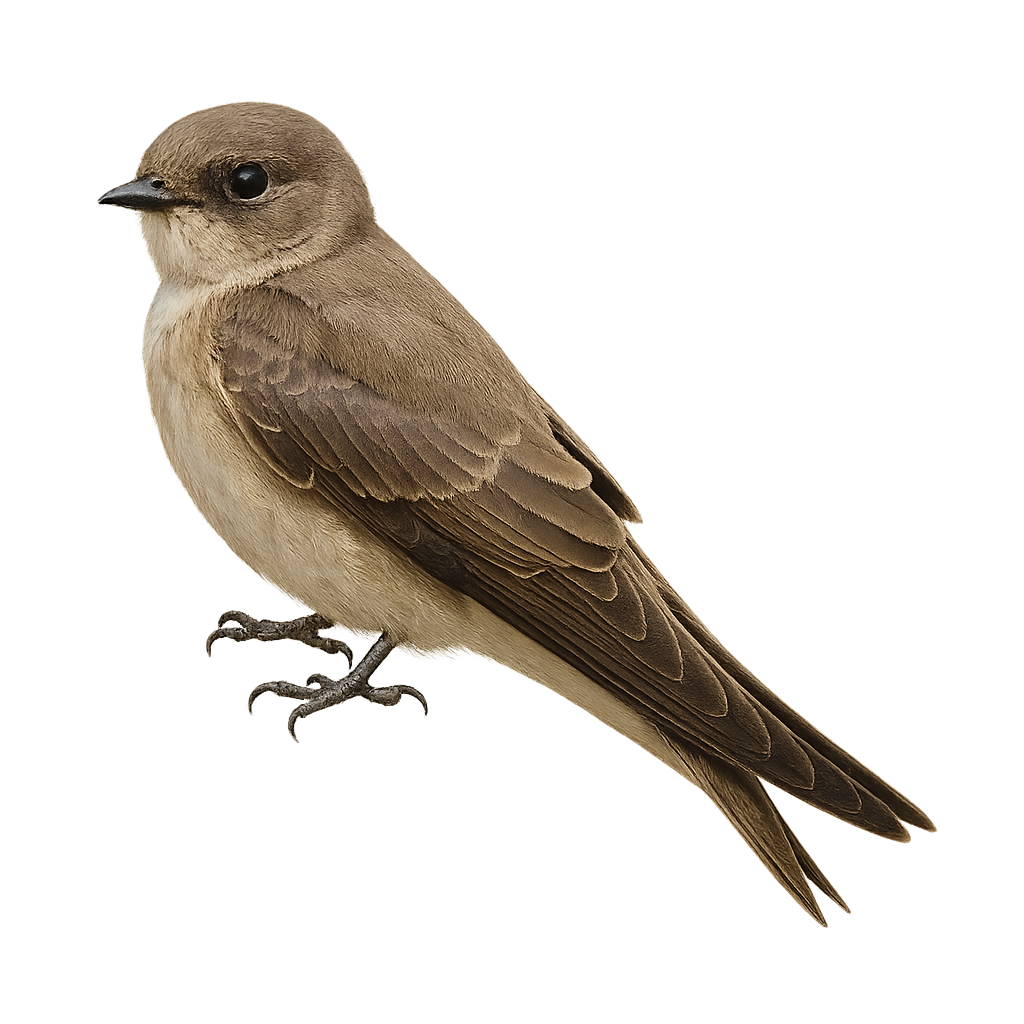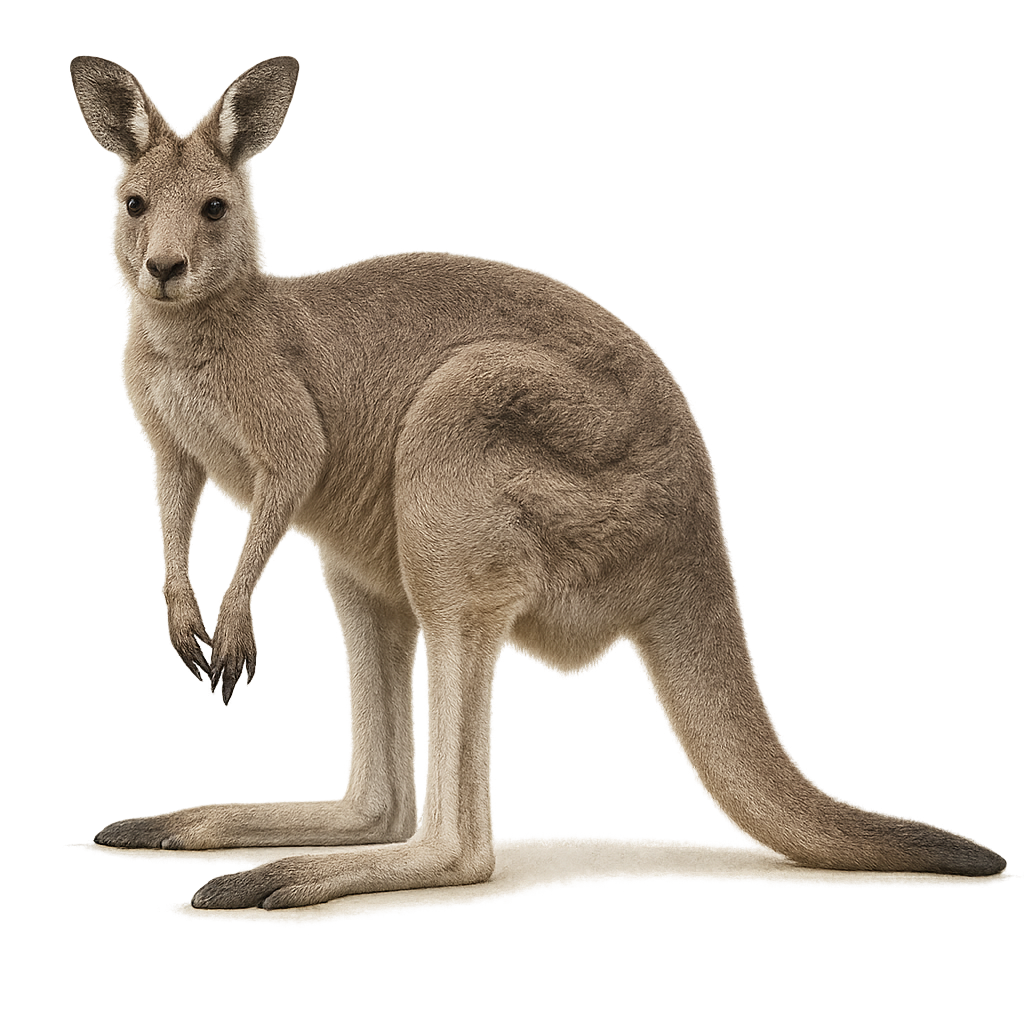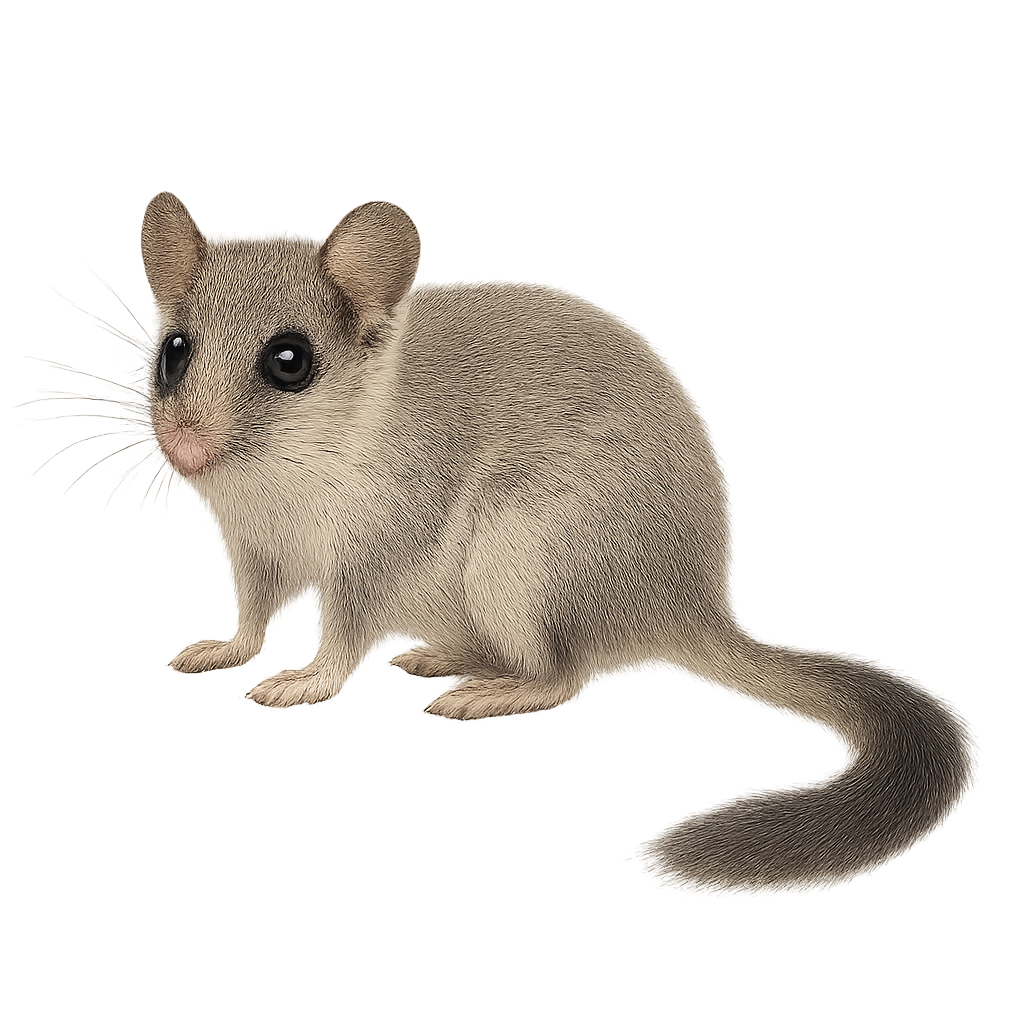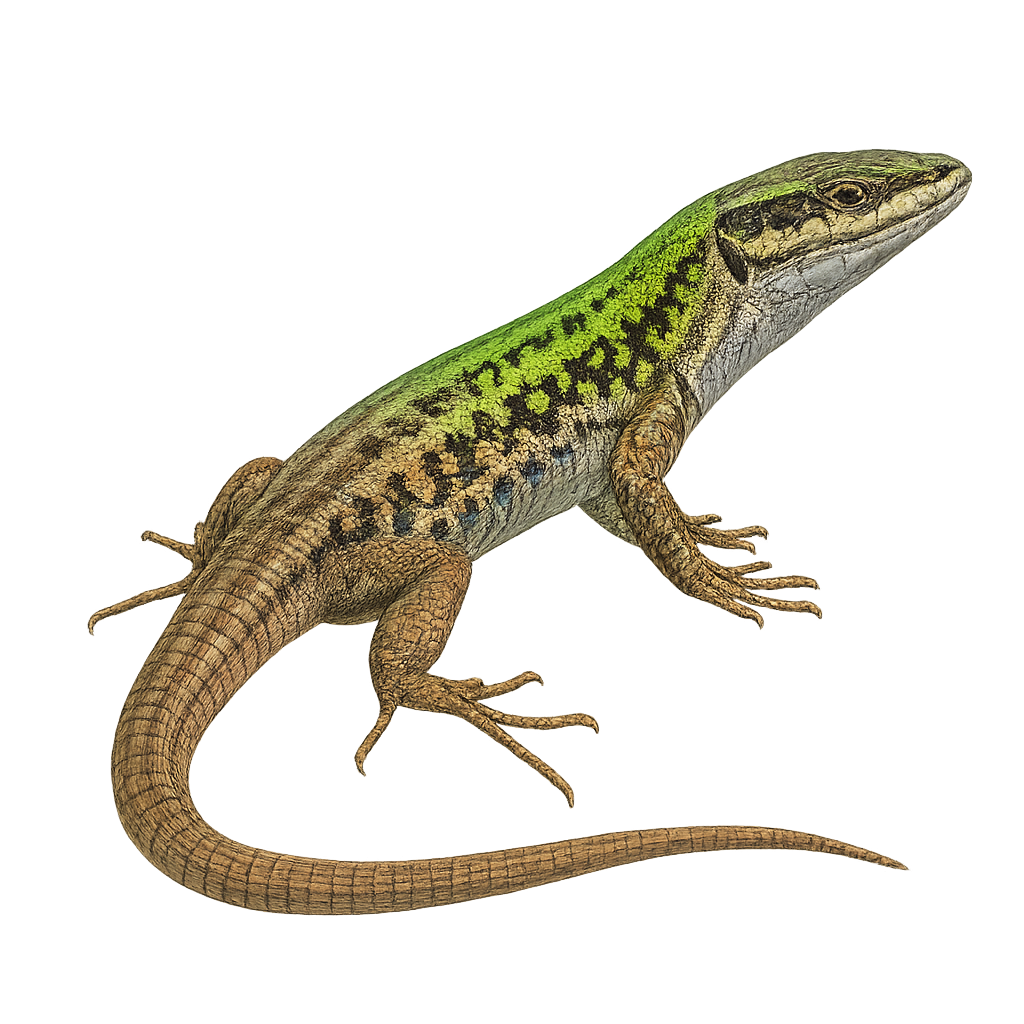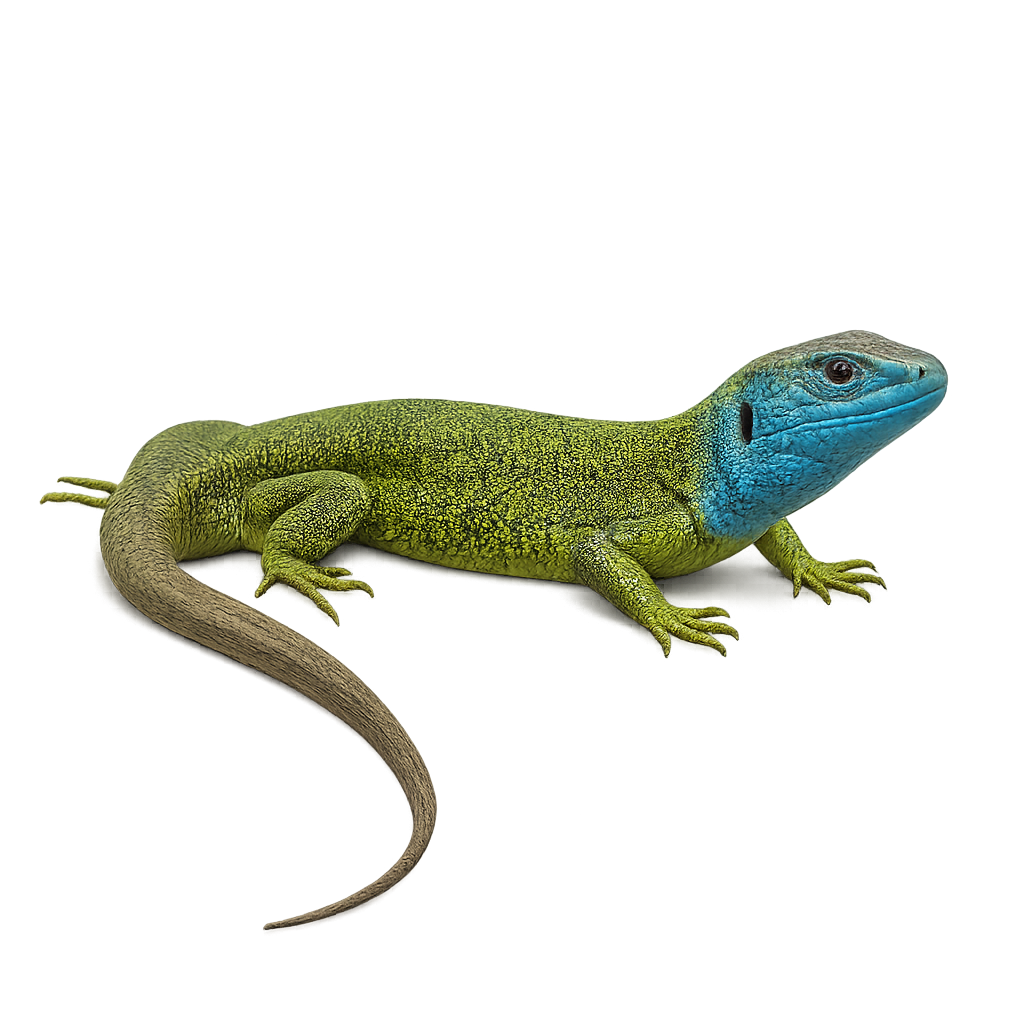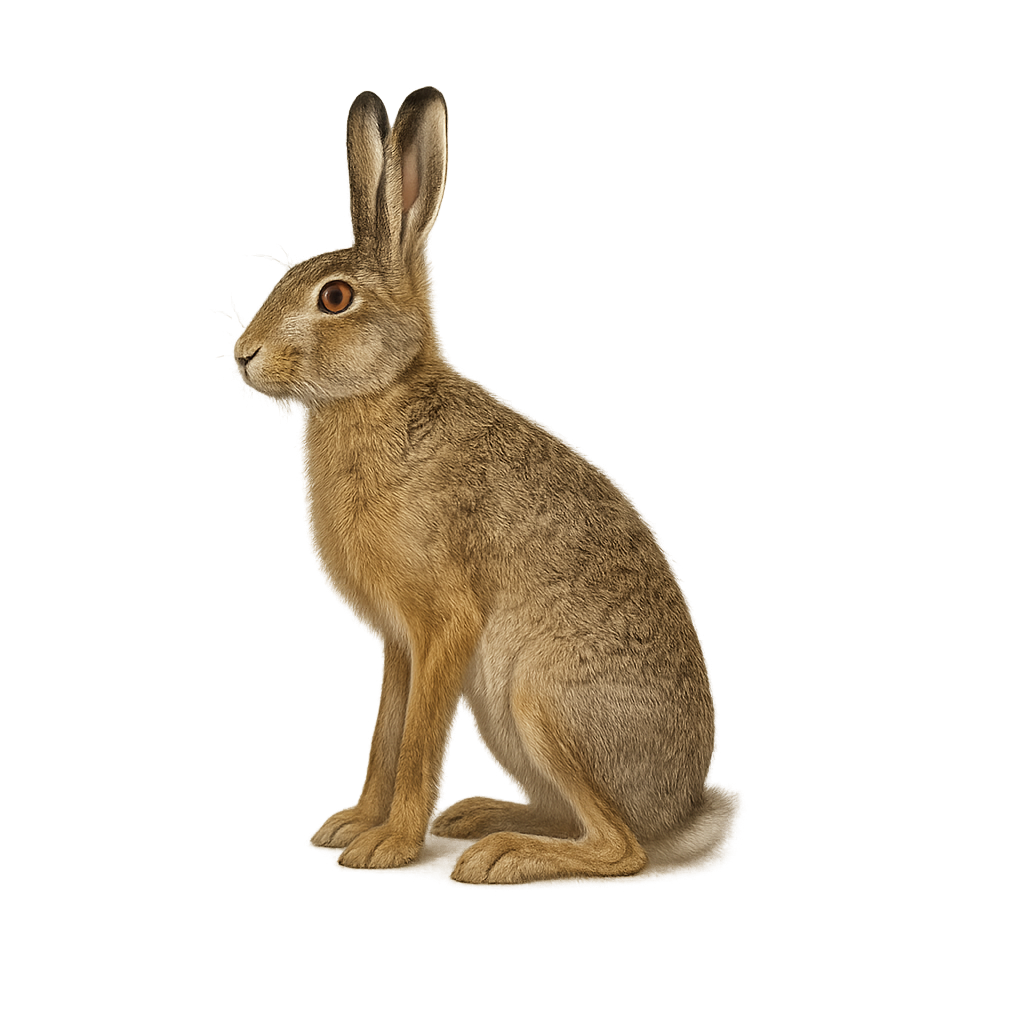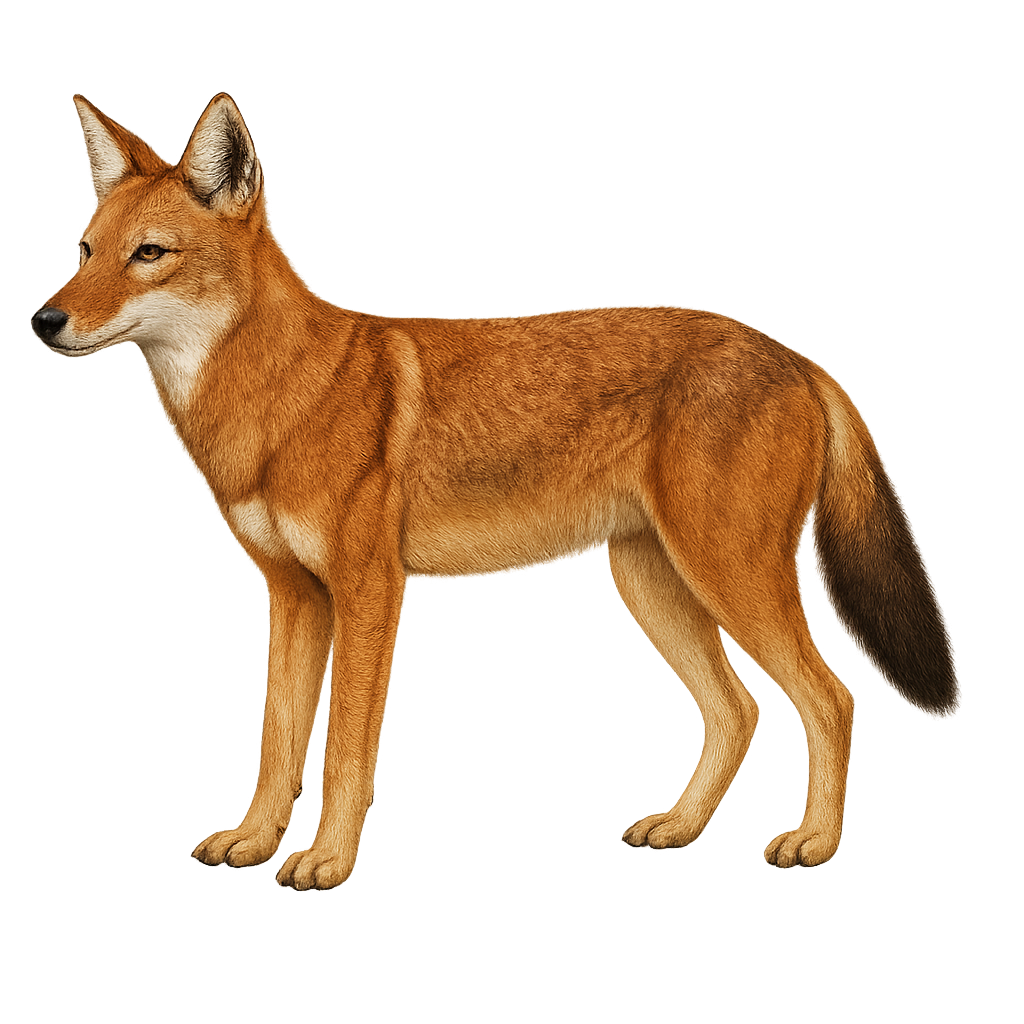The European Nightjar is a nocturnal bird, often difficult to spot due to its perfectly camouflaged plumage that helps it blend into its surroundings. It measures about 23 to 26 cm in length, with a wingspan of 50 to 55 cm. Its plumage is primarily brown, with complex patterns of spots and streaks that perfectly mimic the colors and textures of forest floors or dry meadows. The European Nightjar primarily feeds on nocturnal insects, which it captures in flight with its wide mouth open. It hunts at dusk and during the night, using its broad, rounded wings to maneuver silently through the air. This bird is often seen flying in circles or zigzags above fields, forests, or open areas. During the breeding season, the female lays its eggs directly on the ground, often in well-hidden spots. While the species is not currently endangered, it faces threats such as habitat loss, light pollution, and the decline of nocturnal insects.
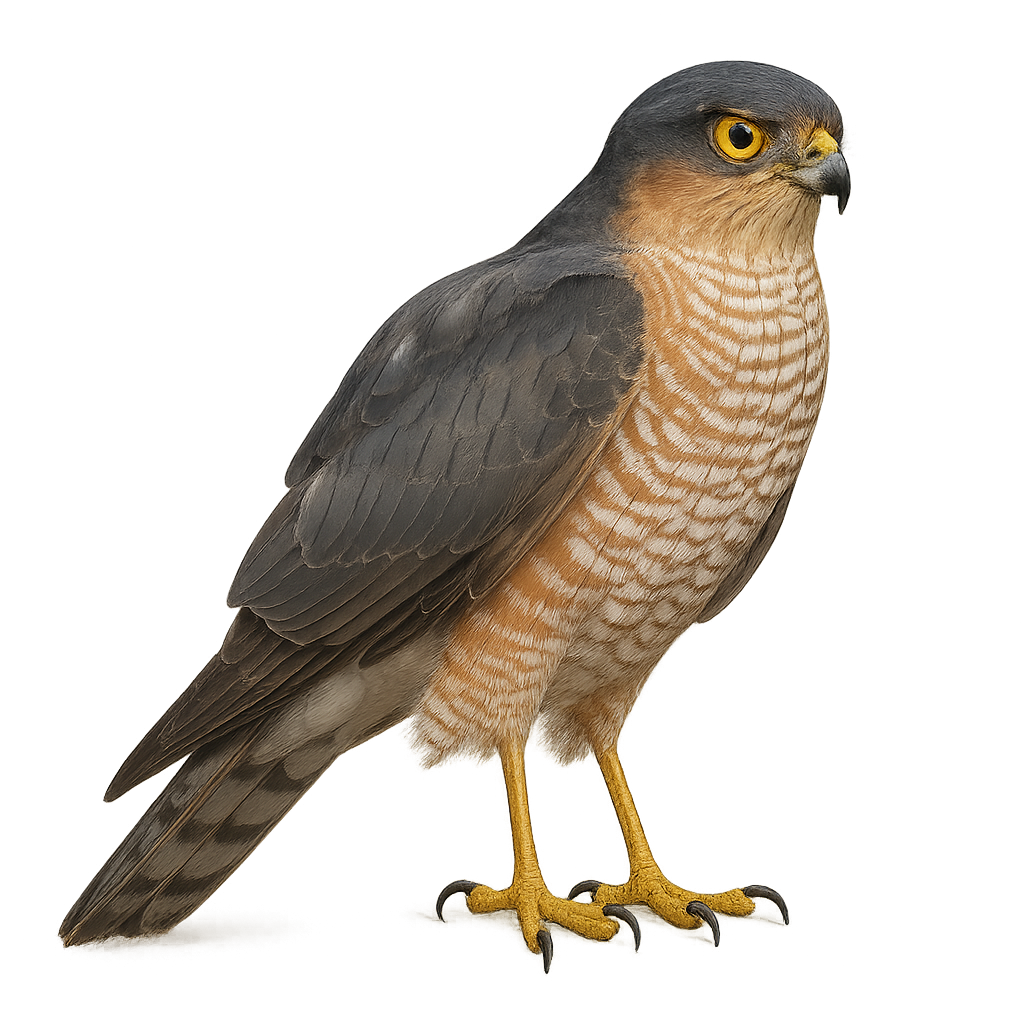
The European Sparrowhawk is a small raptor from the Accipitridae family, easily recognizable by its gray-brown plumage and narrow wings adapted for hunting in forests. It measures about 30 to 40 cm in length, with a wingspan of 60 to 90 cm, and weighs between 150 and 250 g. The male is generally smaller than the female. Its plumage varies depending on sex and age, but adults have bluish-gray feathers on the back and brownish horizontal bars on the belly. The European Sparrowhawk primarily inhabits dense forests and wooded areas in Europe, but it can also be found in urban parks and gardens. This raptor is an excellent hunter, primarily feeding on smaller birds, which it captures in flight after a rapid pursuit through trees. It often hunts using a silent, swift flight technique and is capable of capturing prey in confined spaces. Although the European Sparrowhawk is currently listed as of least concern, it faces threats such as habitat loss, disturbance of its nesting sites, and persecution by humans.
The European starling is a very social bird found across Europe, Asia, and North America. It is easily recognized by its iridescent plumage, which changes color depending on the light. This bird is highly adaptable, living in both urban and rural environments. The European starling is also an excellent imitator, capable of mimicking a variety of sounds, including calls of other birds and human noises. Its ability to form large flocks makes it an ideal subject for group photography.
The Eleonora's Falcon is an elegant and agile bird of prey, renowned for its impressive migrations and unique hunting behavior. It is characterized by its dark plumage and long, pointed wings, which are well-suited for fast and acrobatic flight. This falcon primarily nests on Mediterranean islands, choosing steep cliffs to establish its colonies. It feeds mainly on insects and small birds, which it captures in mid-air. Its breeding strategy is unique among raptors, as it times its nesting period to coincide with the autumn migration of birds, ensuring an abundance of prey to feed its young.
The Hobby Falcon is a small diurnal raptor, often confused with other falcons due to its similar size, but it is distinguished by its elegant plumage and unique characteristics. It measures about 30 to 40 cm in length, with a wingspan of 70 to 90 cm, and weighs between 150 and 250 g. Its plumage is primarily grayish, with a darker head and back and a lighter belly. Males have a lighter plumage than females, which are generally larger and darker. This falcon primarily inhabits open areas such as meadows, heathlands, and sparse forests, as well as mountains and agricultural zones. It hunts by flying at high speed, capturing small birds, insects, and sometimes small mammals. Its flight is fast and direct, often interrupted by sharp turns and dives to capture its prey. While the species is not endangered, it faces threats such as habitat loss and the reduction of its prey populations.
The Eurasian moorhen is an aquatic bird found mainly in wetlands, marshes, lakes, and rivers across Europe, Asia, and North Africa. It is easily recognized by its dark plumage, bright red and yellow beak, and prominent forehead. This aquatic passerine primarily feeds on aquatic plants, small invertebrates, and insects. The moorhen is also known for its discreet behavior and tendency to hide in dense vegetation.
The Uroplatus ebenaui is a fascinating gecko endemic to Madagascar, renowned for its exceptional ability to blend into its surroundings. Its brown coloration and flattened shape allow it to resemble a dead leaf, providing perfect camouflage against predators. Measuring about 10 cm in length, it has a leaf-shaped tail that enhances its mimicry. This nocturnal gecko is primarily arboreal, inhabiting humid tropical forests. It feeds on insects and other small invertebrates. Its reproduction is oviparous, with eggs laid in the forest litter. Although discreet, it plays a crucial role in the ecosystem by regulating insect populations.
The pied flycatcher is a small migratory passerine, 11–13 cm long, with striking black-and-white plumage: the male has a glossy black back and head contrasting with a white belly, while the female shows duller brownish tones. It inhabits open woodlands, forest edges, and parks, feeding mainly on insects and spiders caught in flight or gleaned from foliage. During the breeding season, the male performs aerial chases and sings to attract the female and defend his territory.
The Laniarius aethiopicus, or Ethiopian Boubou, is a bird with distinctive plumage, primarily black with a bright red chest. It inhabits wooded regions and savannas of East Africa. Known for its melodious song and vocal duets, it is often heard at dawn and dusk. It primarily feeds on insects but can also consume fruits and small vertebrates. The Ethiopian Boubou is a territorial bird, often seen in pairs or small family groups. Although relatively common in its natural habitat, it can be challenging to spot due to its discreet behavior and dark plumage that blends into the shadows of the vegetation.
The Mountain Gorilla is a subspecies of gorilla, primarily found in the volcanic mountains of Central Africa, notably in the forests of the Virunga region, between Rwanda, Uganda, and the Democratic Republic of the Congo. This gorilla is smaller than its cousin, the lowland gorilla, with an average height of 1.4 to 1.8 meters and a weight ranging from 140 to 220 kg for males, and 90 to 120 kg for females. Its fur is dense, typically black, with silver-gray hair on the backs of adult males, hence the name "silverback." Mountain Gorillas live in family groups led by a dominant male, the silverback, who is responsible for the protection and well-being of the group. They primarily feed on plants, fruits, leaves, and stems. Although they are peaceful and shy animals, Mountain Gorillas are critically endangered due to habitat loss, illegal hunting, and diseases transmitted by humans.
The Eurasian Eagle-Owl is a large nocturnal raptor, one of the most imposing owls in the world. It measures between 60 and 70 cm in length, with a wingspan of 1.6 to 1.8 meters, and weighs between 1.5 and 4.5 kg. Its plumage is primarily brown, with white and black mottled patterns, and its eyes are bright orange, giving the bird a piercing gaze. It also has tufts of feathers on its head that resemble ears, which give it a distinctive appearance. The Eurasian Eagle-Owl primarily inhabits forests, mountains, and rocky areas in Europe, Western Asia, and the Middle East. It is an opportunistic hunter, feeding mainly on small mammals, birds, and sometimes reptiles or amphibians. The Eurasian Eagle-Owl is a solitary and territorial bird, known for its powerful and deep calls, often heard at night. While the species is not endangered, it may be affected by the destruction of its natural habitat and human disturbances.
The Eared Grebe is a small grebe measuring between 28 and 35 cm in length with a wingspan of 57 to 59 cm. In breeding plumage, it has a black head adorned with golden feathers forming a crest, a black neck, a black chest, and chestnut flanks. In non-breeding plumage, it is more subdued, with a black back, black cap, white cheeks, and a white belly. It frequents shallow lakes and ponds, rich in aquatic vegetation, where it primarily feeds on small fish and aquatic invertebrates. Reproduction occurs in summer, with a clutch of 3 to 6 eggs laid in a floating nest. The young are capable of swimming shortly after hatching and can be carried on the parents' backs. A migratory species, it winters in the Mediterranean and warmer regions. Listed as Least Concern by the IUCN.
The Common Frog is a widespread species of frog in Europe, easily recognized by its brown or green skin, often spotted with dark markings. It primarily lives in wetland areas such as marshes, ponds, and riverbanks. This frog is an opportunist, feeding mainly on insects, worms, and small invertebrates that it captures with its quick tongue. The Common Frog is often seen during its movements toward water for breeding, a characteristic behavior in spring. It is active during the day and evening, although its habits are more pronounced during the breeding season.
The European Bee-eater is a small, colorful bird, easily recognizable by its vibrant plumage, which features a combination of bright colors, mainly blue, green, yellow, and orange. It measures about 28 to 30 cm in length, with a wingspan of 40 to 45 cm, and weighs between 30 and 40 g. Its beak is long and pointed, perfectly adapted to catching insects in flight, primarily wasps, bees, and other flying insects. The European Bee-eater primarily inhabits open areas, grasslands, forest edges, and steppes in Europe, as well as North Africa and Western Asia. It is migratory and mostly travels to sub-Saharan Africa for the winter. This small bird lives in colonies, and its nests are often dug into cliffs or riverbanks. The European Bee-eater is known for its swift flights and acrobatic behavior while capturing its prey. Although the species is not endangered, it may be threatened by habitat loss and human disturbances, such as the degradation of natural habitats.
The Eastern Hedgehog, or Erinaceus concolor, is a small insectivorous mammal found primarily in Eastern Europe and Asia Minor. It is recognizable by its stiff spines covering its back, providing effective protection against predators. This hedgehog is nocturnal, spending its days resting in nests made of leaves and branches. It mainly feeds on insects, worms, and sometimes fruits. Although generally solitary, the Eastern Hedgehog can be observed in small groups during the breeding season. It is capable of hibernating during the winter months, reducing its metabolic activity to survive the cold temperatures.
The Ethiopian Swallow is a small, graceful bird, identifiable by its metallic blue back and white underparts. It has a forked tail typical of swallows. This species is mainly found in sub-Saharan Africa, frequenting open areas, villages, and towns. It is often seen in flight, hunting insects for food. The Ethiopian Swallow is a partial migrant, moving according to seasons and food availability. It builds a cup-shaped nest with mud, often under building eaves. Its population is stable, and it is not considered threatened.
The Eurasian Crag Martin, or Ptyonoprogne rupestris, is a medium-sized bird belonging to the Hirundinidae family. It is identifiable by its uniform brown-grey plumage, slightly lighter on the belly, and its square tail edged with white spots. This species is often found in mountainous and rocky regions of Southern Europe and Central Asia. It builds its cup-shaped nest under rocky overhangs or bridges, using mud and grass. The Eurasian Crag Martin is an agile insectivore, catching its prey in flight. It is a partial migrant, with some populations moving south in winter. Although its habitat is specific, it adapts well to human structures, contributing to its stable population.
The Eurasian Oystercatcher is a coastal bird easily recognizable by its black and white plumage and long orange beak. It measures about 40 to 45 cm in length, with a wingspan of 75 to 85 cm, and weighs between 300 and 400 g. Its beak is long and straight, ideal for digging up shellfish and other mollusks, which it primarily consumes, though it also feeds on worms and marine insects. The Eurasian Oystercatcher primarily inhabits the coasts of Europe, north-west Africa, and parts of Asia. It prefers beaches, estuaries, and mudflats where it can forage at low tide. This bird is very territorial and can be seen in small colonies during the breeding season, but typically lives alone or in small groups outside of that period. Although the species is not immediately endangered, it is sensitive to habitat loss, beach pollution, and human disturbance.
The Eastern Grey Kangaroo, or Macropus giganteus, is a prominent marsupial native to Australia, recognized for its large size and unique hopping locomotion. It has a grey-brown coat with a lighter belly. Males can reach up to 2 meters in height and weigh around 66 kg, while females are generally smaller. These kangaroos live in groups known as "mobs" and are primarily herbivorous, feeding on grasses and leaves. They possess powerful hind legs and a muscular tail used for balance. Although they are mostly active at dusk and dawn, they can also be seen during the day.
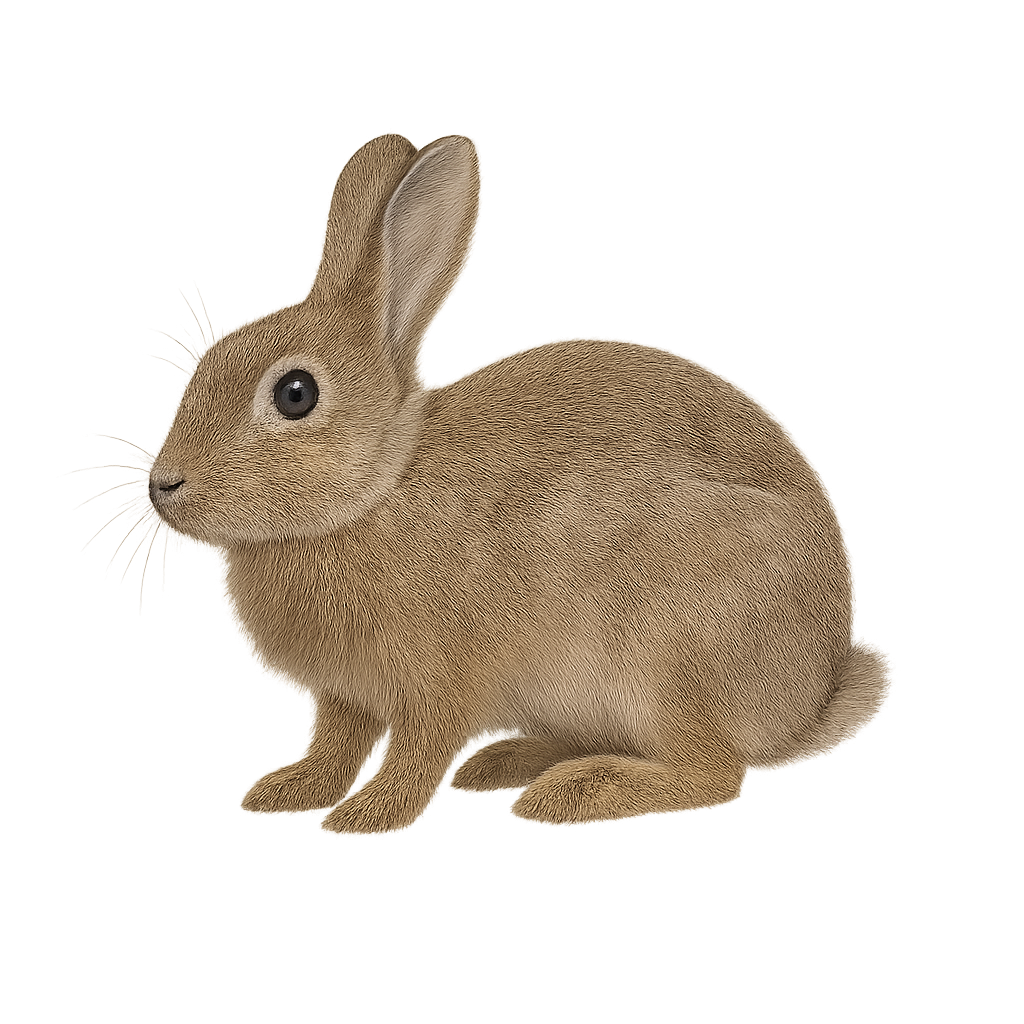
The European Rabbit is a small herbivorous mammal, widely distributed across Europe and in certain parts of the world where it has been introduced. It measures about 40 to 50 cm in length, with a short tail and soft fur that varies from light gray to brown, with a white belly. The European Rabbit is known for its long ears, bright eyes, and powerful hind legs that allow it to leap quickly. It typically lives in groups in burrows called "warrens," which it digs in soft soils or dense vegetation. This rabbit is primarily herbivorous, feeding on grasses, roots, leaves, and fruits. While it is an excellent breeder, with several litters a year, it is vulnerable to predators such as foxes, birds of prey, and carnivores. Despite its large population, the European Rabbit is threatened in some areas by excessive hunting, habitat loss, and the spread of diseases. It plays an important role in ecosystems as prey for many carnivores and as an ecological engineer, digging burrows that alter soil structure.
The Garden Dormouse is a small nocturnal rodent, often compared to a miniature squirrel, found primarily in Europe and Asia. It measures about 20 cm in length, with a tail of around 12 cm, and weighs between 100 and 150 g. Its coat is typically light gray or brown, with a dark line running from its eyes to its back and a lighter area on its belly. The Garden Dormouse is primarily nocturnal and arboreal, feeding on fruits, nuts, seeds, as well as small insects and larvae. It is an excellent climber and takes refuge in trees or crevices to sleep during the day. This rodent is a hibernator, retreating into its nest in the fall to survive the winter, which is essential for its survival in the cold. Although the Garden Dormouse is protected in some areas, it is threatened by deforestation and the reduction of its natural habitat.
The Erhard's wall lizard, or Podarcis erhardii, is a species of lizard found primarily in the Aegean islands and some regions of mainland Greece. This small reptile, typically measuring between 18 and 25 cm in total length, is known for its ability to adapt to various environments, ranging from rocky areas to open grasslands. Its coloration varies from brown to green, often with band or spot patterns, allowing it to blend effectively into its natural habitat. Active mainly during the day, the Erhard's wall lizard feeds on insects, spiders, and other small invertebrates. Although relatively common in its range, it is sensitive to habitat disturbances, particularly due to human development and tourism activities.
The European green lizard is a slender lacertid measuring 15–20 cm in body length, with a tail up to 1.5 times the body length. It has vivid green dorsal coloration and a yellowish-green belly. It inhabits sunny grasslands, woodland edges and rocky areas, feeding on insects and spiders. During the breeding season, males develop brighter colors and perform territorial displays on exposed rocks.
The European Hare is a large herbivorous mammal, easily recognizable by its long ears and powerful hind legs. It measures about 50 to 70 cm in length, with a short tail and a wingspan of 70 to 90 cm, and weighs between 3 and 5 kg. Its coat varies with the seasons: in winter, it becomes lighter, while in summer, it takes on a brown or gray hue, allowing it to blend effectively into fields and meadows. The European Hare is a solitary and territorial animal, primarily found in open areas such as fields, meadows, and sparse woodlands. It is particularly fast and agile, capable of running at speeds of over 60 km/h when pursued. This hare primarily feeds on grasses, leaves, fruits, and roots. Although the species is widespread in Europe, it faces threats from hunting, habitat loss, and human disturbances.
The Gray Dormouse is a small nocturnal rodent, closely related to the Common Dormouse, found mainly in Europe in forests, hedgerows, and gardens. It measures between 10 and 15 cm in length, with a tail of about 8 to 12 cm, and weighs between 40 and 100 g. Its coat is generally light gray or brown-gray, with lighter shades on the belly and dark eyes that give it a lively expression. The Gray Dormouse is an excellent climber and is primarily arboreal. It feeds on fruits, seeds, nuts, and sometimes insects and small worms. This rodent is known for its ability to hibernate during the winter, retreating into natural cavities or nests made of leaves and moss to survive the cold temperatures. While it is relatively common, it is threatened by habitat loss, deforestation, and disturbances caused by human activity.
The European Golden Oriole is a brightly colored bird, easily recognizable by its striking plumage. The male is particularly vivid yellow with black wings, while the female has a more subdued plumage, mainly olive green and yellow. It measures about 25 cm in length and weighs between 40 and 60 g. This migratory passerine bird primarily inhabits open forests, orchards, and hedgerows, mostly in Europe, and migrates to North Africa for the winter. The European Golden Oriole is known for its melodious and powerful song, consisting of clear and repetitive notes. Its diet is primarily insectivorous, feeding on caterpillars, wasps, and other insects, but it also consumes fruits such as berries. This bird is discreet and hard to observe as it spends most of its time high up in trees. While its population is stable in some regions, it is threatened by deforestation, the loss of its natural habitat, and the reduction of its food sources due to pesticide use.
The Ethiopian wolf, or Canis simensis, is a rare and iconic canid of the Ethiopian highlands. With its distinctive reddish coat, it is often mistaken for a fox, although its size and morphology are more akin to a wolf. This predator specializes in hunting rodents, which it captures using keen hearing and solitary hunting techniques. Unfortunately, it is threatened by habitat loss, diseases transmitted by domestic dogs, and population fragmentation. Conservation efforts are crucial to ensure its survival.
The Eastern Wolf is a subspecies of the gray wolf, primarily found in the regions of Eastern Europe, notably in Poland, Romania, Bulgaria, and Ukraine. It measures about 1.2 to 1.5 meters in length, with a tail of 35 to 45 cm, and weighs between 25 and 45 kg, with males generally being larger and more massive than females. Its coat is thick and generally light gray to dark gray, with brown and white shades on the belly and legs. The Eastern Wolf primarily inhabits forests, mountains, and protected areas, where it hunts prey such as deer, wild boars, roe deer, and sometimes small mammals. It is a social predator, living in packs, and cooperates with other members of its group to capture prey. Although this subspecies has been the subject of conservation programs, it remains vulnerable to hunting, habitat loss, and conflicts with humans.
The Eurasian Otter is a semi-terrestrial aquatic mammal found primarily in rivers, lakes, and coastal areas of Eurasia. It measures between 60 and 90 cm in length, with a tail of about 30 to 40 cm, and weighs between 5 and 12 kg. Its coat is thick and waterproof, dark brown on the back and lighter on the belly, allowing it to stay warm and move easily in the water. The Eurasian Otter is an excellent swimmer, using its hind limbs to propel itself and its tail to stabilize. It primarily feeds on fish but can also hunt amphibians, crustaceans, and small mammals. It is a solitary animal or lives in small family groups, marking its territory with traces and droppings. Although the species is protected in many areas, it is threatened by water pollution, habitat loss, and poaching.


